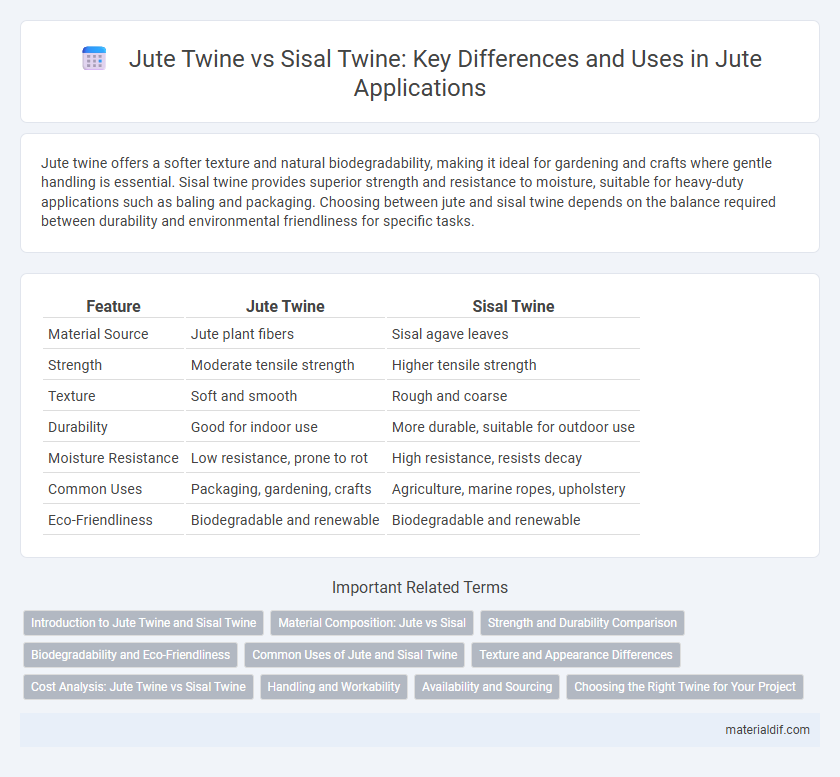Jute twine offers a softer texture and natural biodegradability, making it ideal for gardening and crafts where gentle handling is essential. Sisal twine provides superior strength and resistance to moisture, suitable for heavy-duty applications such as baling and packaging. Choosing between jute and sisal twine depends on the balance required between durability and environmental friendliness for specific tasks.
Table of Comparison
| Feature | Jute Twine | Sisal Twine |
|---|---|---|
| Material Source | Jute plant fibers | Sisal agave leaves |
| Strength | Moderate tensile strength | Higher tensile strength |
| Texture | Soft and smooth | Rough and coarse |
| Durability | Good for indoor use | More durable, suitable for outdoor use |
| Moisture Resistance | Low resistance, prone to rot | High resistance, resists decay |
| Common Uses | Packaging, gardening, crafts | Agriculture, marine ropes, upholstery |
| Eco-Friendliness | Biodegradable and renewable | Biodegradable and renewable |
Introduction to Jute Twine and Sisal Twine
Jute twine, derived from the jute plant, is a natural fiber known for its softness, flexibility, and biodegradability, making it ideal for packaging, gardening, and crafts. Sisal twine, sourced from the agave plant, offers greater strength and durability, suitable for heavy-duty binding and outdoor use. Both fibers provide eco-friendly alternatives to synthetic ropes, with jute excelling in lightweight applications and sisal favored for robustness.
Material Composition: Jute vs Sisal
Jute twine is made from the soft, long fibers of the jute plant's outer skin, resulting in a smooth and flexible texture ideal for crafting and gardening. Sisal twine, derived from the stiff fibers of the sisal agave plant's leaves, offers greater durability and resistance to moisture, making it suitable for heavy-duty outdoor applications. The natural composition of jute provides biodegradability and eco-friendliness, while sisal's coarse fiber structure delivers enhanced strength and abrasion resistance.
Strength and Durability Comparison
Jute twine exhibits moderate strength with a tensile strength ranging between 300 to 600 MPa, making it suitable for light to medium-duty tasks. Sisal twine surpasses jute in durability, offering tensile strength from 400 to 700 MPa and higher resistance to abrasion and moisture, ideal for heavy-duty applications. The natural fibers of sisal provide enhanced longevity and resilience, while jute is more biodegradable but less resistant to environmental wear.
Biodegradability and Eco-Friendliness
Jute twine offers superior biodegradability compared to sisal twine, breaking down naturally within a few months without leaving harmful residues. Its eco-friendliness is enhanced by sustainable cultivation practices and minimal chemical processing, making it an environmentally responsible choice. Sisal twine, while biodegradable, decomposes slower and often requires more intensive processing, which can increase its ecological footprint.
Common Uses of Jute and Sisal Twine
Jute twine is commonly used for gardening, packaging, and crafting due to its soft texture and biodegradable nature, making it ideal for tying plants and bundling lightweight materials. Sisal twine, made from the agave plant, is favored for heavy-duty applications such as agriculture, marine uses, and construction because of its high tensile strength and resistance to moisture. Both jute and sisal twine are eco-friendly alternatives to synthetic ropes, with jute excelling in decorative and light-duty tasks while sisal suits more demanding environments.
Texture and Appearance Differences
Jute twine features a finer, softer texture with a natural golden-brown color that smoothly weaves into crafts and packaging. Sisal twine has a coarser, rougher feel and a pale yellow hue, making it more durable for outdoor and heavy-duty uses. These distinctive textures and appearances influence their suitability for different applications in gardening, agriculture, and decoration.
Cost Analysis: Jute Twine vs Sisal Twine
Jute twine generally costs less than sisal twine due to lower raw material and production expenses, making it a budget-friendly option for packaging and gardening. Sisal twine, while slightly more expensive, offers superior durability and strength, which can justify the higher price in applications requiring long-lasting performance. Evaluating the cost-benefit ratio between jute and sisal twine depends on the specific use case, balancing initial investment against longevity and application demands.
Handling and Workability
Jute twine is softer and more pliable, making it easier to handle and knot securely for delicate tasks, while sisal twine is stiffer and rougher, providing better grip for heavy-duty bundling and outdoor use. Jute's finer texture allows for smoother tying without fraying, whereas sisal's coarser fibers offer greater abrasion resistance and durability under tension. Both twines excel in different applications, with jute preferred for crafts and gardening, and sisal favored for rugged packing and marine purposes.
Availability and Sourcing
Jute twine is widely available due to the extensive cultivation of jute plants in countries like India and Bangladesh, making sourcing relatively consistent and cost-effective. Sisal twine primarily originates from East African nations such as Tanzania and Kenya, where sisal agave plants are grown, leading to more regional availability and slightly higher sourcing costs. Supply chains for jute benefit from established global trade networks, whereas sisal twine sourcing can be more variable depending on regional agricultural output.
Choosing the Right Twine for Your Project
Jute twine offers softness and flexibility, making it ideal for gardening, crafts, and light-duty packaging where easy tying and a natural appearance are important. Sisal twine provides superior strength and durability, suitable for heavy-duty tasks like agriculture, construction, and bundling materials that require more resistance to wear and weather. Selecting the right twine depends on project requirements for tensile strength, environmental exposure, and aesthetic preference between natural fiber textures.
Jute Twine vs Sisal Twine Infographic

 materialdif.com
materialdif.com